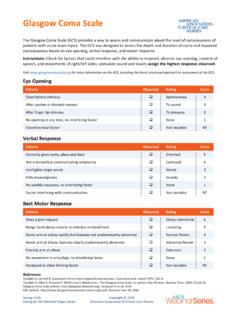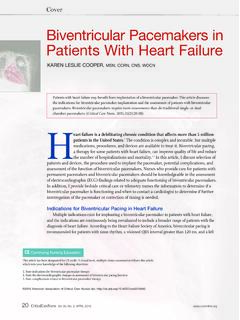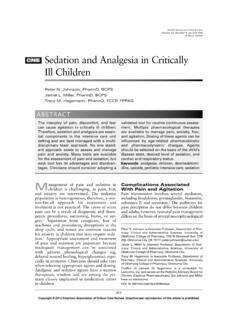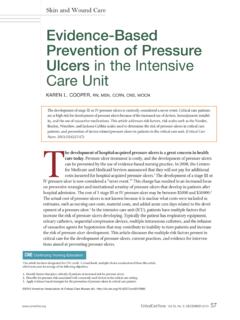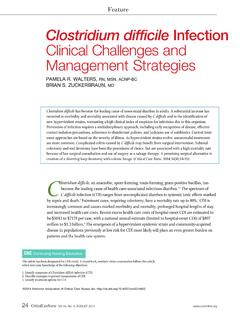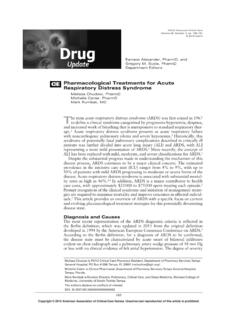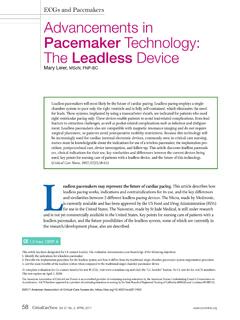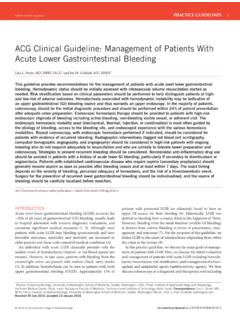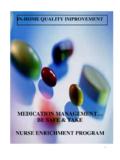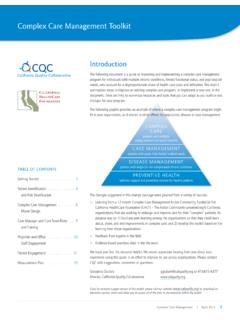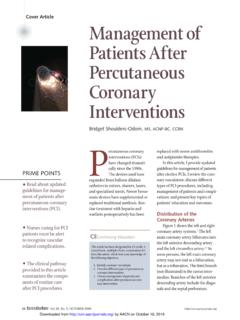Transcription of Effective Pain Management and Improvements in Patients ...
1 FeatureEffective pain Management and Improvements in Patients Outcomes and SatisfactionDiane Glowacki, RN, MSN, CNS, CNRN-CMCA dequate pain Management is a compelling and universal requirement in health care. Despite considerable advancements, the adverse physiological and psychological implications of unmanaged pain remain substantially unresolved. Ineffective pain Management can lead to a marked decrease in desirable clinical and psychological outcomes and Patients overall quality of life. Effective Management of acute pain results in improved patient outcomes and increased patient satisfaction. Although research and advanced treat-ments in improved practice protocols have documented progressive Improvements in Management of acute and postoperative pain , little awareness of the effectiveness of best practices persists. Improved interventions can enhance Patients attitudes to and perceptions of pain .
2 What a patient believes and understands about pain is critical in influencing the patient s reaction to the pain therapy provided. Use of interdisciplinary pain teams can lead to Improvements in Patients pain Management , pain education, outcomes, and satisfaction. (Critical Care Nurse. 2015;35[3]:33-43) 2015 American Association of Critical-Care Nurses doi: article has been designated for CE credit. A closed-book, multiple-choice examination follows this article, which tests your knowledge of the following objectives:1. Discuss improved outcomes for Effective pain management2. Review the use of evidence-based practice in pain Management and assessment3. Describe the pathophysiology of pain and its impact on the patient CE Continuing EducationEffective pain Management is a national and global challenge. Lack of integration of current knowledge and practice of Effective pain Management by health care professionals into day-to-day care adversely affects Patients , resulting in unnecessary physical, psychological, and emotional Implementation of research findings on pain Management has slowly evolved and led to Improvements in patient The Joint Commission and the World Health Organization, along with many national professional organizations and agencies, have recognized that pain Management is an essential aspect of patient CriticalCareNurse Vol 35, No.
3 3, JUNE 2015 33 Author Diane Glowacki is a clinical nurse specialist at Mercy Hospital of Buffalo, Buffalo, New York. She has held nursing leadership roles in project Management , program development, process changes in best practice, and evidence-based clinical nursing practice. She led the development of a designated New York State stroke center and has had roles in stroke coordination. She leads the pain Management team and assists in developing strategies to improve Patients expe-rience and satisfaction. Corresponding author: Diane Glowacki, RN, MSN, CNS, CNRN-CMC, Mercy Hospital of Buffalo, 565 Abbott Rd, Buffalo, NY 14220 (e-mail: purchase electronic or print reprints, contact the American Association of Critical-Care Nurses, 101 Columbia, Aliso Viejo, CA 92656. Phone, (800) 899-1712 or (949) 362-2050 (ext 532); fax, (949) 362-2049; e-mail, CriticalCareNurse Vol 35, No. 3, JUNE 2015 this article, I discuss improved outcomes due to Effective pain Management in Patients with acute pain , highlight the dimensions of pain Management , review use of recommended evidence-based practices in pain Management and assessment, describe the pathophysi-ology of pain , update research findings on multimodal balanced analgesia, and report the increase in patient satisfaction related to Effective pain Management .)
4 Par-ticipation of Mercy Hospital of Buffalo, Buffalo, New York, in a National Database of Nursing Quality Indicators (NDNQI) study revealed successful methods that have positively affected nursing practice and procedural has been defined as an unpleasant physical, sensory and emotional experience associated with actual or potential tissue damage, as well as [an] unpleasant and therefore also an emotional experience. 3 According to McCaffery,4 pain is whatever the experiencing person says it is, existing whenever the experiencing person says it does. Dimensions of pain ManagementFive identified dimensions contribute to pain man-agement. The dimensions have physiological, sensory, affective or cognitive, and sociocultural components unique for each patient that should be Research on pain Management in the 1970s and 1980s peaked as a breakthrough in theoretical knowledge of the physiological, psychological, and social aspects of improved quality of life associated with pain relief, but application of the findings to the general practice of medicine have been Aggressive pain control is still lacking for Patients with acute ,7 Although some concepts have been integrated into practice to enhance Effective pain Management , application of the concepts in the treatment of Patients with pain has been slow,7- 9 despite the availability of efficacious analgesics and multiple published clinical practice guidelines for Management of acute.
5 7 The American pain Soci-ety published the most current guidelines10 in 2005 for improving the Management of acute pain and cancer pain (the initial guidelines were released in 1995). The 5 most current guidelines include prompt recognition and treatment of pain , involvement of Patients in the pain Management plan, improvement of treatment patterns, reassessment and adjustment of the pain Management plan as needed, and monitoring processes and outcomes of pain Acute pain can be due to surgery, an injury, or a pathophysiological event such as ischemia or embolus. The central nervous system (CNS) conveys signals from the spinal cord to the brain, then to the nerves, and finally throughout the body. The spinal and supra- spinal components of the CNS play critical roles. Both the peripheral and the central nervous systems are involved with the perception of pain . The peripheral system includes both motor and sensory nerves.
6 Afferent nerves receive information, or stimuli, and efferent nerves carry the sensation to the muscles and stimulate tissue injury and the effect of physical stress on the body, the sympathetic nervous system is acti-vated, and damaged cells trigger a cascade of changes in the peripheral and central systems, releasing chem-ical mediators such as catecholamines, cytokines, and inflammatory markers at the cellular level, causing fur-ther tissue ,12 The signals from these peripheral neurotransmitters intensify the noxious process. The signals travel through afferent pathways to the dorsal horn of the spinal cord, reach the subcortical and corti-cal areas of the brain, which play a role in the transmis-sion of pain centrally through the spinal cord, and thus provoke pain13 (Table 1). At the cellular level, this series of events results in vasodilatation, increased vascular permeability, and activation of inflammatory cells that affect cardiovascular, gastrointestinal, renal, endocrine, respiratory, and metabolic functions and cause sup-pression of the immune system, which can result in postoperative infections and delayed ,6 The potential for depression and anxiety also often occurs with mismanaged CriticalCareNurse Vol 35, No.
7 3, JUNE 2015 35 Patients OutcomesAdequate pain Management enhances earlier mobility and lessens the complications of ileus, urinary retention, and myocardial infarction. Sleep deprivation, which can increase postoperative fatigue, resulting in decreased mobility, is also reduced, as are pulmonary complications, and an aggravated catabolic hormonal response to ,15 When physiological complica-tions are better controlled, Patients and their families a re better able to respond to stress and to cope with the patient s ,6 Additional benefits of ade-quate pain Management include decreased length of stay, lower readmission rates, earlier overall recovery,16 improved quality of life, increased productivity, and decreased costs for Patients and the health care ,17 During the early 2000s, the dissemination of research, science, and evidence-based practice was slowly embraced by clinicians, even though the literature had long described available pain interventions and methods to reduce potential The American pain Society developed one of the fi rst national quality improvement programs in which the emphasis shifted from improved delivery of Effective pain Management to measurable patient outcomes, such as decreased length of stay, reduced hospital costs, and increased patient of pain education provided to Patients about preoperative and postoperative surgical procedures and expectations can result in poorer outcomes for the Patients .
8 Egbert et al18 reported that providing pain education to preoperative and postoperative Patients resulted in signifi cant Improvements in the Patients outcomes. Patients who received pain education required 50% fewer narcotics during hospitalization, excluding the day of the procedure, and were discharged sooner than were Patients who did not receive the education. When acute pain is predictable, providing Effective pain education and information on the anticipated postop-erative experience should include special regard to the multiple causes and effects of pain , along with the range of treatments available to a patient. This pain education can reduce Patients distress, reduce the number of signs and symptoms, and improve functional What a patient believes and understands about pain is critical in infl uencing the reaction to the pain therapy pain education alone may be the most Effective treatment provided by health care clinical practice guidelines of the American pain Society recommend that Patients and their families receive pain education during the presurgical visit that includes an explanation of the surgical procedure; the expected postoperative routine; the interventions and options for pain relief, including available pain medica-tion; and the need for progressive increased mobility.
9 Proper education and adequate treatment of postoperative pain can also result in positive emotional outcomes for Patients , such as a decrease in anxiety and depression, Table 1 The pain pathway and analgesic interventions that can modulate activity at each point of the central and the peripheral nervous systemsaProgression of eventsInjury or traumaleads to Peripheral nociceptor stimulation and release of noxious neurotransmittersleads to Peripheral nerves travel through ascending or afferent central nervous system pathwayleads to Signal reaches dorsal root ganglion, which has synapses in the dorsal horn of the spinal cord Signal travels along the spinothalamic tract to the thalamus and cortexleads to Paina Based on information from Gottschalk and interventionsLocal anestheticsTraditional nonsteroidal anti-infl ammatory drugsCyclooxygenase-2 inhibitorsLocal anestheticsLocal anestheticsOpioids_-AgonistsCyclooxygena se-2 specifi c inhibitorsCentrally acting analgesicsA thorough pain history and shared goal setting are critical components of Effective pain Management that leads to beneficial CriticalCareNurse Vol 35, No.
10 3, JUNE 2015 increase in coping skills, a greater sense of individual control, and an increase in a sense of ,18 improvement of pain AssessmentsLack of proficient and uniform pain assessment is one of the most challenging barriers in achieving ade-quate pain ,19 The most acknowledged and rec-ognized barrier to Effective pain assessment is Patients subjectivity, the individual, personal, and private expe-riences within the dimensions of pain Management . Assessment of a patient s pain requires that profes-sionals become well educated in recognizing a patient s perception of pain , previous experiences with pain , current knowledge of pain , spiritual and religious beliefs, and sociocultural ,5 A thorough pain his-tory and shared goal setting are critical components of Effective pain Management that leads to beneficial Synergistic concepts of pain assessments are complex and include assessment of a patient s clinical status, pain history, age, body weight, comorbid condi-tions, psychological status, previous exposure to anal-gesic medication, opioid-naive status (an opioid-naive patient is one who has not previously received opioid drugs and now, often because of trauma or surgery, receives regular daily doses of opioids)
